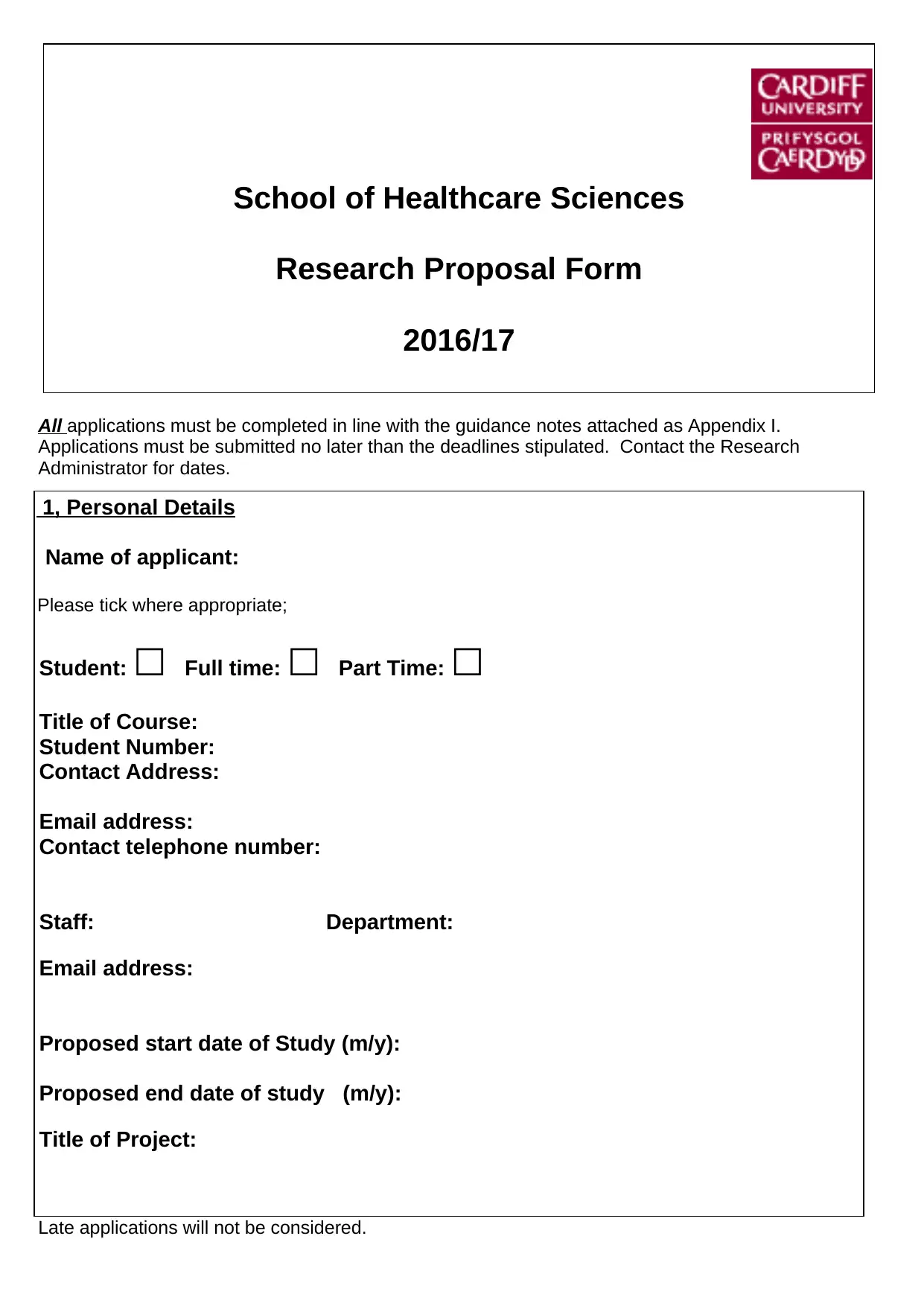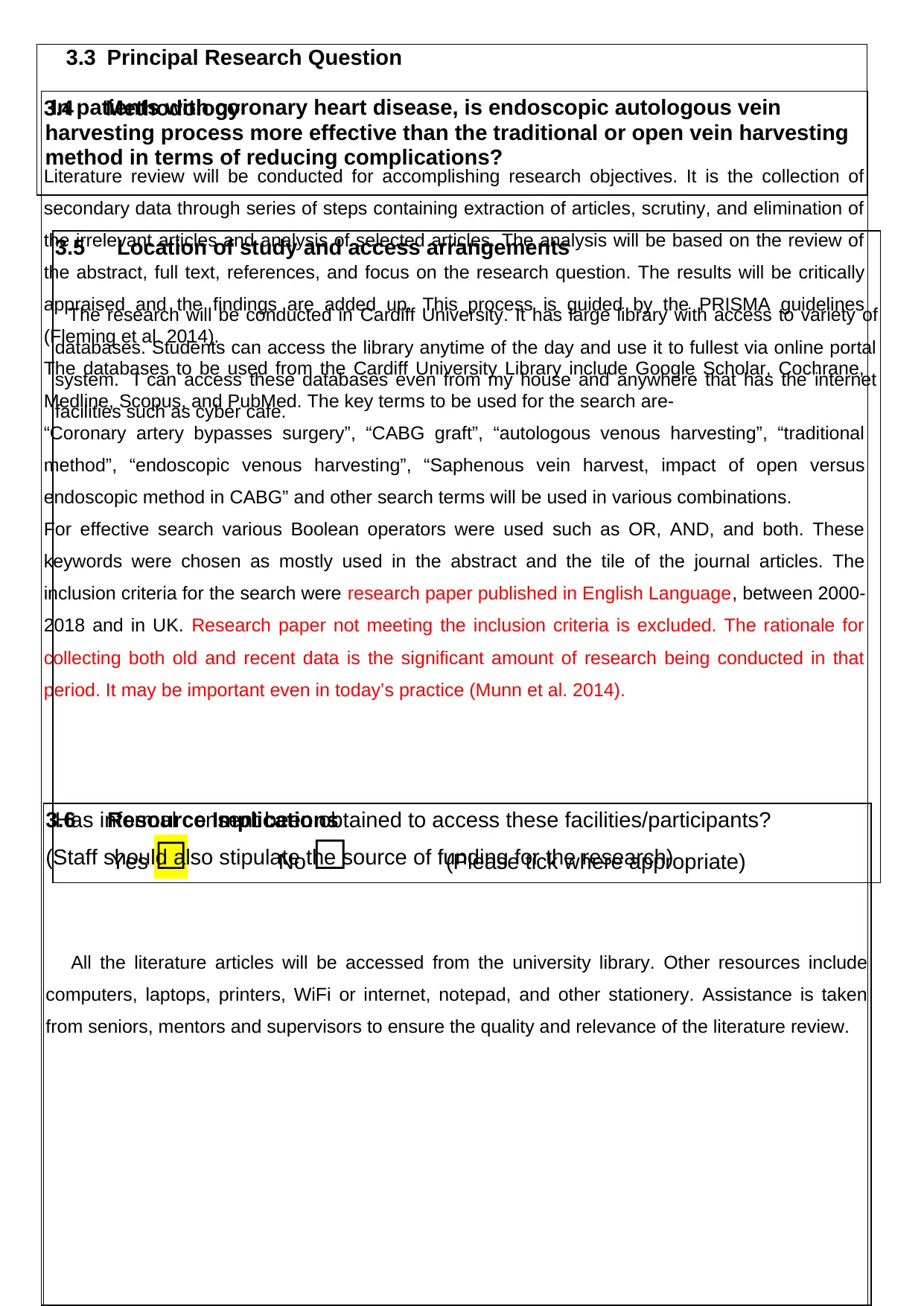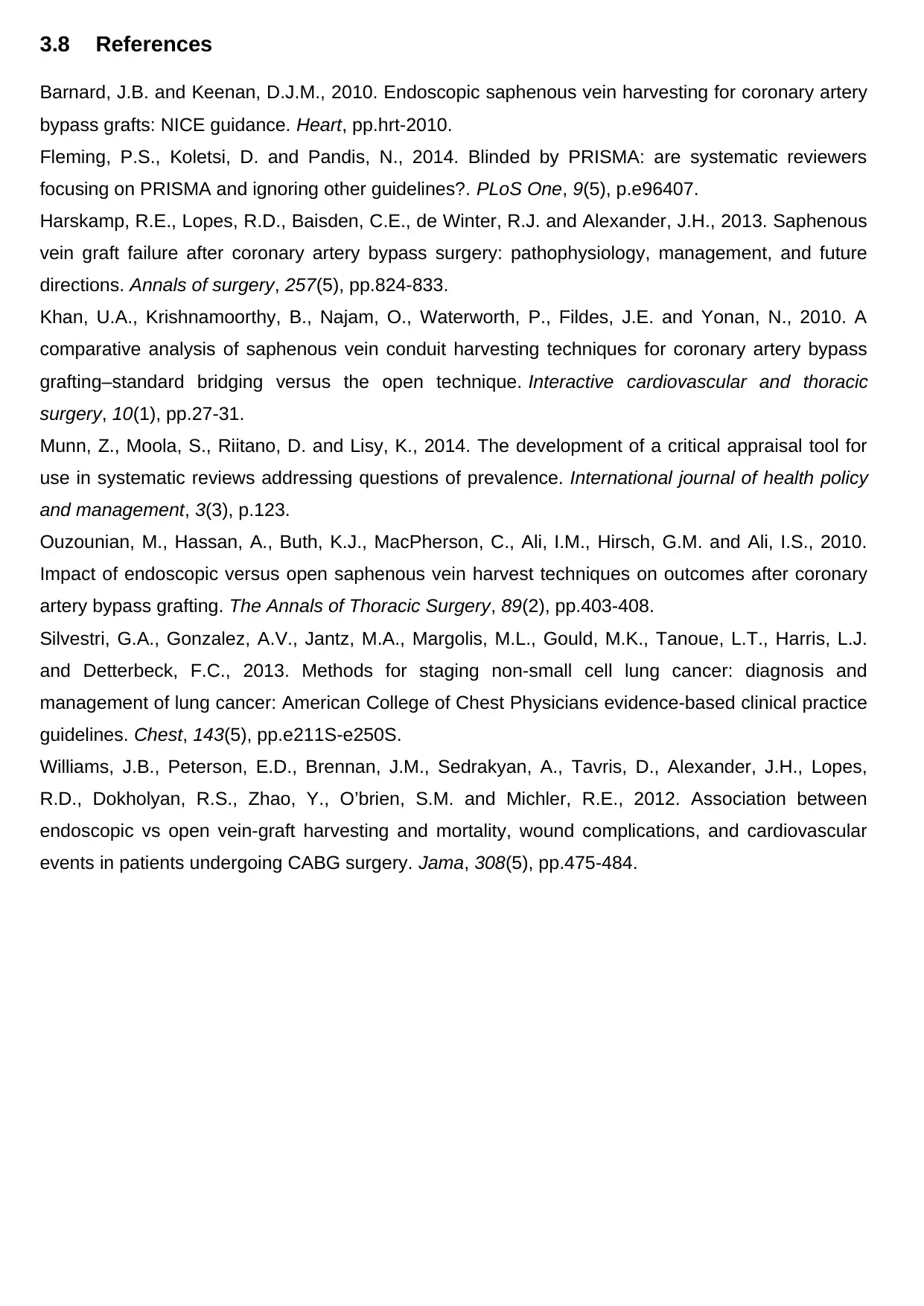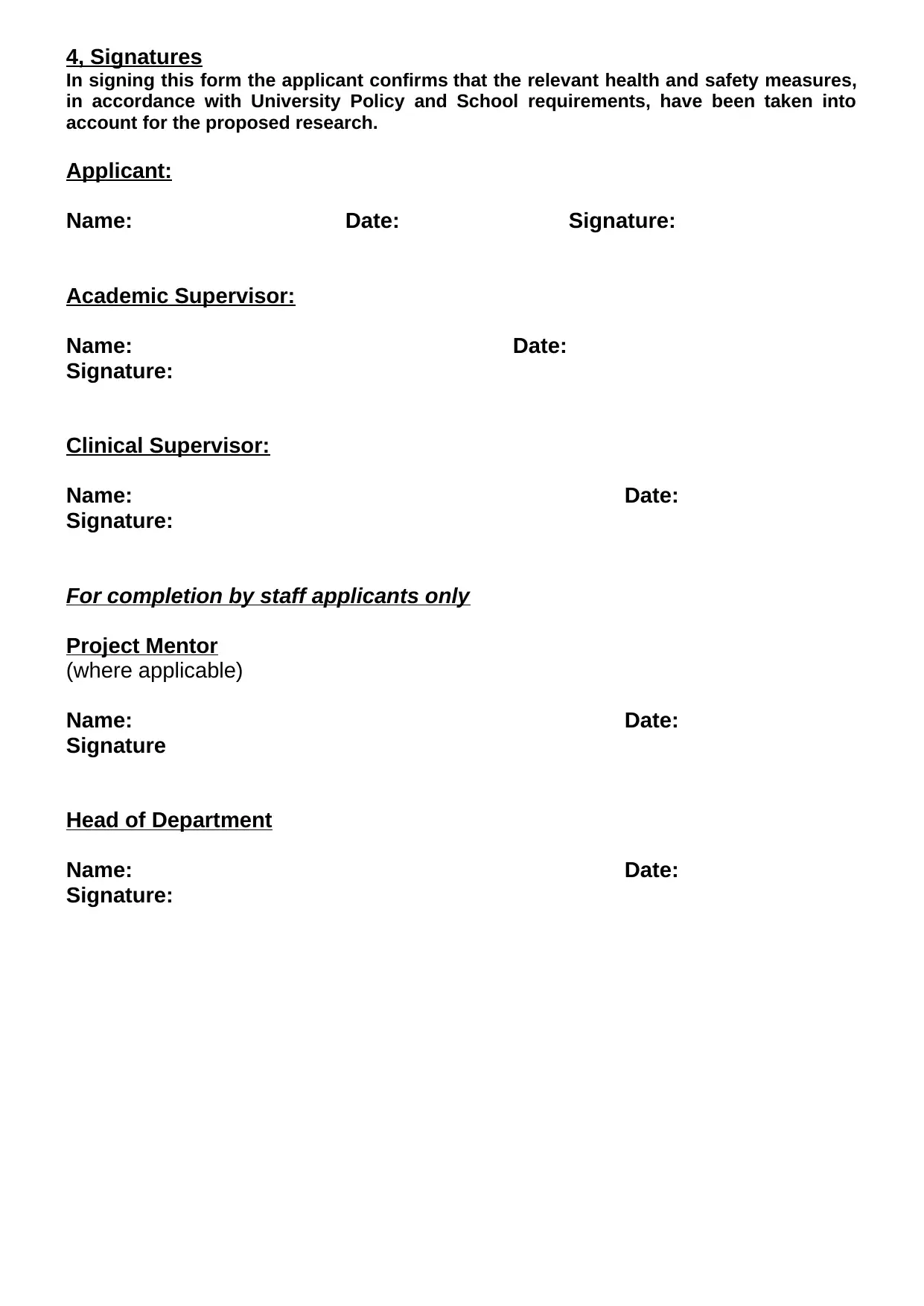Research Proposal Form for School of Healthcare Sciences
VerifiedAdded on 2023/06/15
|7
|2129
|187
AI Summary
This is a research proposal form for the School of Healthcare Sciences. It includes personal details, project details, methodology, ethical considerations, and project milestones. The proposed research is about comparing the efficacy of endoscopic autologous vein harvesting process with the traditional or open vein harvesting method in terms of reducing complications in patients with coronary heart disease. The research will be conducted in Cardiff University and will involve a literature review based on the PRISMA guidelines.
Contribute Materials
Your contribution can guide someone’s learning journey. Share your
documents today.

All applications must be completed in line with the guidance notes attached as Appendix I.
Applications must be submitted no later than the deadlines stipulated. Contact the Research
Administrator for dates.
Late applications will not be considered.
School of Healthcare Sciences
Research Proposal Form
2016/17
1, Personal Details
Name of applicant:
Please tick where appropriate;
Student: ☐ Full time: ☐ Part Time: ☐
Title of Course:
Student Number:
Contact Address:
Email address:
Contact telephone number:
Staff: Department:
Email address:
Proposed start date of Study (m/y):
Proposed end date of study (m/y):
Title of Project:
Applications must be submitted no later than the deadlines stipulated. Contact the Research
Administrator for dates.
Late applications will not be considered.
School of Healthcare Sciences
Research Proposal Form
2016/17
1, Personal Details
Name of applicant:
Please tick where appropriate;
Student: ☐ Full time: ☐ Part Time: ☐
Title of Course:
Student Number:
Contact Address:
Email address:
Contact telephone number:
Staff: Department:
Email address:
Proposed start date of Study (m/y):
Proposed end date of study (m/y):
Title of Project:
Secure Best Marks with AI Grader
Need help grading? Try our AI Grader for instant feedback on your assignments.

2, Additional Information
Where the project is part of an undergraduate or postgraduate course
Full name of academic supervisor:
Address:
Where the research is being carried out by a member of staff please provide details of co-
investigators
Full Name/s:
Department/School/Institution:
3, Project Details
3.1 Lay Summary
People with coronary artery disease are treated with one procedure known as “coronary artery
bypass graft surgery” or CABG. This disease is characterised by narrowing of coronary arteries. It
is caused by building up of the plaques in the arterial walls, which narrows the inside of the
arteries. In this process the oxygen rich blood reaching the heart muscle is reduced. Therefore, the
blocked portion is bypassed by treating the narrowed artery with another piece of blood vessels or
grafts. One of the methods is harvesting a vein from calf areas of legs or inner thighs usually called
the long saphenous vein. It is also called as autologous venous harvesting (Williams et al. 2012).
There are different forms of harvesting procedures such as open of the vein for grafting, and
endoscopic vein harvesting. The former is known as the traditional approach. There is a debate on
efficacy of the both methods. As per the literature, there are fewer complications with the
endoscopic method when compared to the traditional approach. The traditional approach is
considered to be associated with complications, increased hospital stay, leg pain, and other.
However, the endoscopic method too has its disadvantages. At the time of harvest, there is a risk
of injury. There is also probability of deteriorating effect on the vein graft patency (Barnard and
Keenan 2010).
In order to decide which type of procedure is most effective and beneficial in treating the coronary
artery disease, a critical analysis of the literature will be conducted. Collecting the best evidence
will guide the future effective practice. The data collected from the literature review will help health
care professionals in clinical judgement and decision-making related to surgeries (Silvestri et al.
2013).
3.2 Background and Objectives of Study
Autologous vein harvesting using the extra luminal vein dissector to obtain the sephaneous vein
was found to be beneficial in coronary artery disease patients. The symptomatic benefits include
early mobility and low superficial inflammation. There was no excessive trauma to the vein or any
sign of distraction injury found in the patients. This technique was found to be more effective than
the more traditional dissection technique. There are few studies on this method highlighting
drawbacks (Harskamp et al., 2013). Similarly, using the standard bridging technique for
autologous vein harvesting when compared to the traditional open harvesting technique was found
to be effective in reducing the postoperative leg morbidity. The bridging method was effective in
increasing the patient satisfaction as it was found financially viable (Khan et al., 2010). However,
there is still limited evidence related to functional quality of the vein using the method.
According to Ouzounian et al. (2010) endoscopic saphenous vein harvest is effective in decreasing
the leg wound infections after surgery. It has also been found to improve cosmesis after CABG.
On the other hand it has also been found to reduce the graft patency rates. Other studies
contradict that endoscopic method is not the sole factor for the mid-term adverse outcomes of in-
hospital outcomes. However, drawback of harvesting saphenous vein method includes it limited
visibility using endoscope. Even with illumination, the light is only emitted at the distal portion of the
endoscope. There is need to periodically cleaning the endoscope lens as it gets frequently soiled
on touching the tissue. It is instead considered safer than the open vein harvesting or the excision
method.
An extended literature review will be conducted to identify the effective methods of autologous
venous harvesting in CABG out of traditional approach and the endoscopic method in reducing the
complications after the surgery.
Where the project is part of an undergraduate or postgraduate course
Full name of academic supervisor:
Address:
Where the research is being carried out by a member of staff please provide details of co-
investigators
Full Name/s:
Department/School/Institution:
3, Project Details
3.1 Lay Summary
People with coronary artery disease are treated with one procedure known as “coronary artery
bypass graft surgery” or CABG. This disease is characterised by narrowing of coronary arteries. It
is caused by building up of the plaques in the arterial walls, which narrows the inside of the
arteries. In this process the oxygen rich blood reaching the heart muscle is reduced. Therefore, the
blocked portion is bypassed by treating the narrowed artery with another piece of blood vessels or
grafts. One of the methods is harvesting a vein from calf areas of legs or inner thighs usually called
the long saphenous vein. It is also called as autologous venous harvesting (Williams et al. 2012).
There are different forms of harvesting procedures such as open of the vein for grafting, and
endoscopic vein harvesting. The former is known as the traditional approach. There is a debate on
efficacy of the both methods. As per the literature, there are fewer complications with the
endoscopic method when compared to the traditional approach. The traditional approach is
considered to be associated with complications, increased hospital stay, leg pain, and other.
However, the endoscopic method too has its disadvantages. At the time of harvest, there is a risk
of injury. There is also probability of deteriorating effect on the vein graft patency (Barnard and
Keenan 2010).
In order to decide which type of procedure is most effective and beneficial in treating the coronary
artery disease, a critical analysis of the literature will be conducted. Collecting the best evidence
will guide the future effective practice. The data collected from the literature review will help health
care professionals in clinical judgement and decision-making related to surgeries (Silvestri et al.
2013).
3.2 Background and Objectives of Study
Autologous vein harvesting using the extra luminal vein dissector to obtain the sephaneous vein
was found to be beneficial in coronary artery disease patients. The symptomatic benefits include
early mobility and low superficial inflammation. There was no excessive trauma to the vein or any
sign of distraction injury found in the patients. This technique was found to be more effective than
the more traditional dissection technique. There are few studies on this method highlighting
drawbacks (Harskamp et al., 2013). Similarly, using the standard bridging technique for
autologous vein harvesting when compared to the traditional open harvesting technique was found
to be effective in reducing the postoperative leg morbidity. The bridging method was effective in
increasing the patient satisfaction as it was found financially viable (Khan et al., 2010). However,
there is still limited evidence related to functional quality of the vein using the method.
According to Ouzounian et al. (2010) endoscopic saphenous vein harvest is effective in decreasing
the leg wound infections after surgery. It has also been found to improve cosmesis after CABG.
On the other hand it has also been found to reduce the graft patency rates. Other studies
contradict that endoscopic method is not the sole factor for the mid-term adverse outcomes of in-
hospital outcomes. However, drawback of harvesting saphenous vein method includes it limited
visibility using endoscope. Even with illumination, the light is only emitted at the distal portion of the
endoscope. There is need to periodically cleaning the endoscope lens as it gets frequently soiled
on touching the tissue. It is instead considered safer than the open vein harvesting or the excision
method.
An extended literature review will be conducted to identify the effective methods of autologous
venous harvesting in CABG out of traditional approach and the endoscopic method in reducing the
complications after the surgery.

3.3 Principal Research Question
In patients with coronary heart disease, is endoscopic autologous vein
harvesting process more effective than the traditional or open vein harvesting
method in terms of reducing complications?
3.4 Methodology
Literature review will be conducted for accomplishing research objectives. It is the collection of
secondary data through series of steps containing extraction of articles, scrutiny, and elimination of
the irrelevant articles and analysis of selected articles. The analysis will be based on the review of
the abstract, full text, references, and focus on the research question. The results will be critically
appraised and the findings are added up. This process is guided by the PRISMA guidelines
(Fleming et al. 2014).
The databases to be used from the Cardiff University Library include Google Scholar, Cochrane,
Medline, Scopus, and PubMed. The key terms to be used for the search are-
“Coronary artery bypasses surgery”, “CABG graft”, “autologous venous harvesting”, “traditional
method”, “endoscopic venous harvesting”, “Saphenous vein harvest, impact of open versus
endoscopic method in CABG” and other search terms will be used in various combinations.
For effective search various Boolean operators were used such as OR, AND, and both. These
keywords were chosen as mostly used in the abstract and the tile of the journal articles. The
inclusion criteria for the search were research paper published in English Language, between 2000-
2018 and in UK. Research paper not meeting the inclusion criteria is excluded. The rationale for
collecting both old and recent data is the significant amount of research being conducted in that
period. It may be important even in today’s practice (Munn et al. 2014).
3.5 Location of study and access arrangements
The research will be conducted in Cardiff University. It has large library with access to variety of
databases. Students can access the library anytime of the day and use it to fullest via online portal
system. I can access these databases even from my house and anywhere that has the internet
facilities such as cyber cafe.
Has informal consent been obtained to access these facilities/participants?
Yes ☐ No ☐ (Please tick where appropriate)
3.6 Resource Implications
(Staff should also stipulate the source of funding for the research)
All the literature articles will be accessed from the university library. Other resources include
computers, laptops, printers, WiFi or internet, notepad, and other stationery. Assistance is taken
from seniors, mentors and supervisors to ensure the quality and relevance of the literature review.
In patients with coronary heart disease, is endoscopic autologous vein
harvesting process more effective than the traditional or open vein harvesting
method in terms of reducing complications?
3.4 Methodology
Literature review will be conducted for accomplishing research objectives. It is the collection of
secondary data through series of steps containing extraction of articles, scrutiny, and elimination of
the irrelevant articles and analysis of selected articles. The analysis will be based on the review of
the abstract, full text, references, and focus on the research question. The results will be critically
appraised and the findings are added up. This process is guided by the PRISMA guidelines
(Fleming et al. 2014).
The databases to be used from the Cardiff University Library include Google Scholar, Cochrane,
Medline, Scopus, and PubMed. The key terms to be used for the search are-
“Coronary artery bypasses surgery”, “CABG graft”, “autologous venous harvesting”, “traditional
method”, “endoscopic venous harvesting”, “Saphenous vein harvest, impact of open versus
endoscopic method in CABG” and other search terms will be used in various combinations.
For effective search various Boolean operators were used such as OR, AND, and both. These
keywords were chosen as mostly used in the abstract and the tile of the journal articles. The
inclusion criteria for the search were research paper published in English Language, between 2000-
2018 and in UK. Research paper not meeting the inclusion criteria is excluded. The rationale for
collecting both old and recent data is the significant amount of research being conducted in that
period. It may be important even in today’s practice (Munn et al. 2014).
3.5 Location of study and access arrangements
The research will be conducted in Cardiff University. It has large library with access to variety of
databases. Students can access the library anytime of the day and use it to fullest via online portal
system. I can access these databases even from my house and anywhere that has the internet
facilities such as cyber cafe.
Has informal consent been obtained to access these facilities/participants?
Yes ☐ No ☐ (Please tick where appropriate)
3.6 Resource Implications
(Staff should also stipulate the source of funding for the research)
All the literature articles will be accessed from the university library. Other resources include
computers, laptops, printers, WiFi or internet, notepad, and other stationery. Assistance is taken
from seniors, mentors and supervisors to ensure the quality and relevance of the literature review.

3.8 Project Milestones and Timescales
3.7 Ethical Considerations
Outline the potential ethical issues of the proposed research and how you intend addressing
these issues.
The research work involves no communication or involvement with the patients. Literature review
is the dry research and the major ethical issue is plagiarism. For this paper, plagiarism will be
avoided and all the relevant literature will be cited and the acknowledgement will be stated. The aim
is to make the literature review interesting and useful for evidence based practice. The review will
be subjected to open scrutiny by the project mentor to judge its worth.
Is NHS R & D approval required? Yes ☐ No ☐
If so which Trusts will be required to give approval?
Is NHS Research Ethics Service approval required? Yes☐ No ☐
Does your research involves children and young people? Yes☐ No☐
If yes, please indicate whether, or not, you have read and understood the University’s
Safeguarding Children and Vulnerable Adults Policy
A copy of which can be found at: http://www.cardiff.ac.uk/racdv/ethics/guidelines/FINAL
%20Safeguarding%20Children%20&%20VAs%20Policy%202010.doc
Yes- I have read and understand the Policy ☐
No – I have not read or understood the Policy ☐
(Tick where appropriate)
3.7 Ethical Considerations
Outline the potential ethical issues of the proposed research and how you intend addressing
these issues.
The research work involves no communication or involvement with the patients. Literature review
is the dry research and the major ethical issue is plagiarism. For this paper, plagiarism will be
avoided and all the relevant literature will be cited and the acknowledgement will be stated. The aim
is to make the literature review interesting and useful for evidence based practice. The review will
be subjected to open scrutiny by the project mentor to judge its worth.
Is NHS R & D approval required? Yes ☐ No ☐
If so which Trusts will be required to give approval?
Is NHS Research Ethics Service approval required? Yes☐ No ☐
Does your research involves children and young people? Yes☐ No☐
If yes, please indicate whether, or not, you have read and understood the University’s
Safeguarding Children and Vulnerable Adults Policy
A copy of which can be found at: http://www.cardiff.ac.uk/racdv/ethics/guidelines/FINAL
%20Safeguarding%20Children%20&%20VAs%20Policy%202010.doc
Yes- I have read and understand the Policy ☐
No – I have not read or understood the Policy ☐
(Tick where appropriate)
Paraphrase This Document
Need a fresh take? Get an instant paraphrase of this document with our AI Paraphraser

Activity Start Date Completion Date
(Estimated)
Discuss the topic with mentor February February
Writing the research proposal March March
Present the proposal to the supervisor and
further discussions
March March
Submission of research proposal March March
Conduct literature review and extract
relevant articles to approve from mentor
April April
Critical analysis of the selected papers
after approval and elimination of the
irrelevant literature
April May
Introduction to dissertation and
methodology
May July
Completed literature review as per
structure
July August
Consult the dissertation supervisor September September
Proceed with conclusion and abstract October October
Proofreading and submission October November
(Estimated)
Discuss the topic with mentor February February
Writing the research proposal March March
Present the proposal to the supervisor and
further discussions
March March
Submission of research proposal March March
Conduct literature review and extract
relevant articles to approve from mentor
April April
Critical analysis of the selected papers
after approval and elimination of the
irrelevant literature
April May
Introduction to dissertation and
methodology
May July
Completed literature review as per
structure
July August
Consult the dissertation supervisor September September
Proceed with conclusion and abstract October October
Proofreading and submission October November

3.8 References
Barnard, J.B. and Keenan, D.J.M., 2010. Endoscopic saphenous vein harvesting for coronary artery
bypass grafts: NICE guidance. Heart, pp.hrt-2010.
Fleming, P.S., Koletsi, D. and Pandis, N., 2014. Blinded by PRISMA: are systematic reviewers
focusing on PRISMA and ignoring other guidelines?. PLoS One, 9(5), p.e96407.
Harskamp, R.E., Lopes, R.D., Baisden, C.E., de Winter, R.J. and Alexander, J.H., 2013. Saphenous
vein graft failure after coronary artery bypass surgery: pathophysiology, management, and future
directions. Annals of surgery, 257(5), pp.824-833.
Khan, U.A., Krishnamoorthy, B., Najam, O., Waterworth, P., Fildes, J.E. and Yonan, N., 2010. A
comparative analysis of saphenous vein conduit harvesting techniques for coronary artery bypass
grafting–standard bridging versus the open technique. Interactive cardiovascular and thoracic
surgery, 10(1), pp.27-31.
Munn, Z., Moola, S., Riitano, D. and Lisy, K., 2014. The development of a critical appraisal tool for
use in systematic reviews addressing questions of prevalence. International journal of health policy
and management, 3(3), p.123.
Ouzounian, M., Hassan, A., Buth, K.J., MacPherson, C., Ali, I.M., Hirsch, G.M. and Ali, I.S., 2010.
Impact of endoscopic versus open saphenous vein harvest techniques on outcomes after coronary
artery bypass grafting. The Annals of Thoracic Surgery, 89(2), pp.403-408.
Silvestri, G.A., Gonzalez, A.V., Jantz, M.A., Margolis, M.L., Gould, M.K., Tanoue, L.T., Harris, L.J.
and Detterbeck, F.C., 2013. Methods for staging non-small cell lung cancer: diagnosis and
management of lung cancer: American College of Chest Physicians evidence-based clinical practice
guidelines. Chest, 143(5), pp.e211S-e250S.
Williams, J.B., Peterson, E.D., Brennan, J.M., Sedrakyan, A., Tavris, D., Alexander, J.H., Lopes,
R.D., Dokholyan, R.S., Zhao, Y., O’brien, S.M. and Michler, R.E., 2012. Association between
endoscopic vs open vein-graft harvesting and mortality, wound complications, and cardiovascular
events in patients undergoing CABG surgery. Jama, 308(5), pp.475-484.
Barnard, J.B. and Keenan, D.J.M., 2010. Endoscopic saphenous vein harvesting for coronary artery
bypass grafts: NICE guidance. Heart, pp.hrt-2010.
Fleming, P.S., Koletsi, D. and Pandis, N., 2014. Blinded by PRISMA: are systematic reviewers
focusing on PRISMA and ignoring other guidelines?. PLoS One, 9(5), p.e96407.
Harskamp, R.E., Lopes, R.D., Baisden, C.E., de Winter, R.J. and Alexander, J.H., 2013. Saphenous
vein graft failure after coronary artery bypass surgery: pathophysiology, management, and future
directions. Annals of surgery, 257(5), pp.824-833.
Khan, U.A., Krishnamoorthy, B., Najam, O., Waterworth, P., Fildes, J.E. and Yonan, N., 2010. A
comparative analysis of saphenous vein conduit harvesting techniques for coronary artery bypass
grafting–standard bridging versus the open technique. Interactive cardiovascular and thoracic
surgery, 10(1), pp.27-31.
Munn, Z., Moola, S., Riitano, D. and Lisy, K., 2014. The development of a critical appraisal tool for
use in systematic reviews addressing questions of prevalence. International journal of health policy
and management, 3(3), p.123.
Ouzounian, M., Hassan, A., Buth, K.J., MacPherson, C., Ali, I.M., Hirsch, G.M. and Ali, I.S., 2010.
Impact of endoscopic versus open saphenous vein harvest techniques on outcomes after coronary
artery bypass grafting. The Annals of Thoracic Surgery, 89(2), pp.403-408.
Silvestri, G.A., Gonzalez, A.V., Jantz, M.A., Margolis, M.L., Gould, M.K., Tanoue, L.T., Harris, L.J.
and Detterbeck, F.C., 2013. Methods for staging non-small cell lung cancer: diagnosis and
management of lung cancer: American College of Chest Physicians evidence-based clinical practice
guidelines. Chest, 143(5), pp.e211S-e250S.
Williams, J.B., Peterson, E.D., Brennan, J.M., Sedrakyan, A., Tavris, D., Alexander, J.H., Lopes,
R.D., Dokholyan, R.S., Zhao, Y., O’brien, S.M. and Michler, R.E., 2012. Association between
endoscopic vs open vein-graft harvesting and mortality, wound complications, and cardiovascular
events in patients undergoing CABG surgery. Jama, 308(5), pp.475-484.

4, Signatures
In signing this form the applicant confirms that the relevant health and safety measures,
in accordance with University Policy and School requirements, have been taken into
account for the proposed research.
Applicant:
Name: Date: Signature:
Academic Supervisor:
Name: Date:
Signature:
Clinical Supervisor:
Name: Date:
Signature:
For completion by staff applicants only
Project Mentor
(where applicable)
Name: Date:
Signature
Head of Department
Name: Date:
Signature:
In signing this form the applicant confirms that the relevant health and safety measures,
in accordance with University Policy and School requirements, have been taken into
account for the proposed research.
Applicant:
Name: Date: Signature:
Academic Supervisor:
Name: Date:
Signature:
Clinical Supervisor:
Name: Date:
Signature:
For completion by staff applicants only
Project Mentor
(where applicable)
Name: Date:
Signature
Head of Department
Name: Date:
Signature:
1 out of 7
![[object Object]](/_next/static/media/star-bottom.7253800d.svg)

